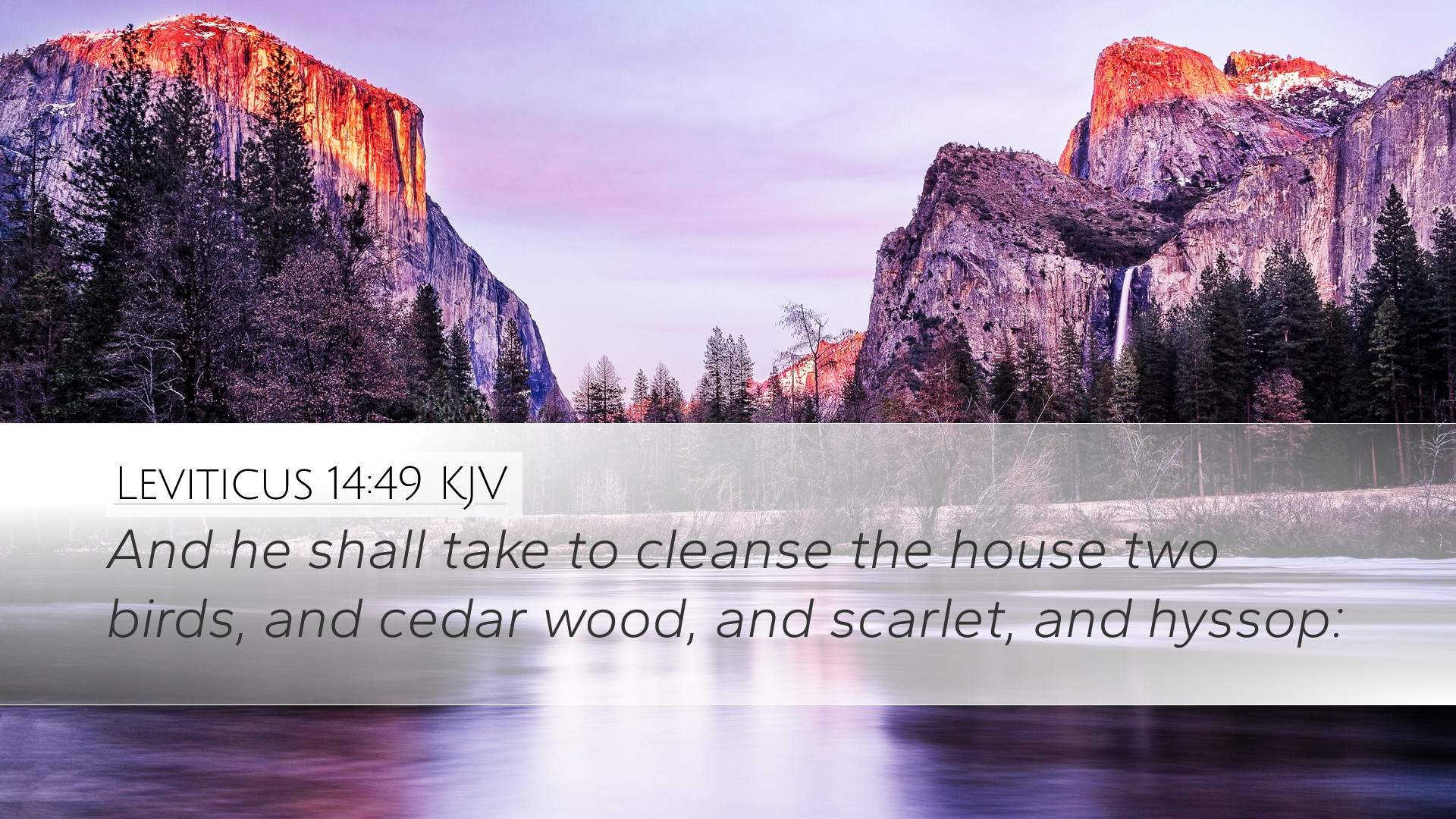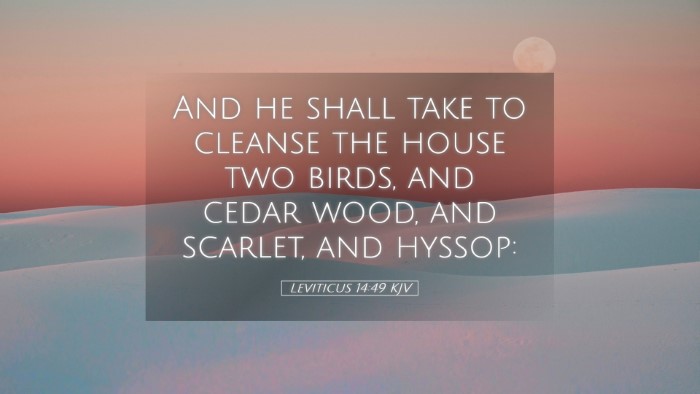Commentary on Leviticus 14:49
Verse Reference: Leviticus 14:49 - "And he shall take to cleanse the house two birds, and cedar wood, and scarlet, and hyssop."
Introduction
The verses surrounding Leviticus 14 focus primarily on the laws regarding leprosy, not just in individuals, but also in dwelling places. This legislation underscores the holiness that God demands from His people and the need for purity in all aspects of life, including the homes where they dwell. The inclusion of specific elements in the purification process reflects both cultural significance and divine instruction.
Understanding the Elements of Purification
In Leviticus 14:49, we see the combined use of two birds, cedar wood, scarlet, and hyssop. Each of these items is rich in symbolism and serves a purpose in the cleansing ritual.
Two Birds
The choice of two birds has been interpreted by many as a representation of duality in God's work—life and death, judgment, and mercy. One bird is sacrificed, symbolizing the idea of atonement for sin and the death that comes from God’s judgment on impurity, while the other is set free, symbolizing the release from sin and the hope of divine mercy.
- Matthew Henry emphasizes that the living bird, set free, signifies the hope of deliverance and life restored.
- Adam Clarke points out that the aspect of life is crucial as it mirrors resurrection themes found throughout Scripture.
Cedar Wood
Cedar wood is noted for its durability and pleasant fragrance. It is often symbolic of strength and endurance. It signifies that the structure—the house—will be treated with care and respect. For the Israelites, cedar was associated with the construction of the Temple, invoking reverence for God's presence.
- Albert Barnes denotes the wood as emblematic of God’s eternal nature and the lasting covenant He has with His people.
- Henry further elaborates that wood in sacrifice can represent the humanity of Christ, highlighting His participation in suffering.
Scarlet
Scarlet dye has profound implications; it often symbolizes sin in a biblical context, but it also represents the blood of Christ—shed for forgiveness and atonement. This duality highlights the grim reality of sin while also encompassing the grace offered through Christ’s sacrifice.
- Barnes interprets the scarlet as a call to remember the price of atonement, tying it to the greater narrative of Christ's redeeming work.
- Clarke suggests that the scarlet evokes the imagery of the Passover, where the blood on the doorposts signaled protection from judgment.
Hyssop
Hyssop is often used in the context of purification rites in Scripture. It symbolizes cleansing and is famously associated with the application of the blood during the Passover, representing both protection and sanctification.
- Henry sees hyssop as a representation of faith, as it must be used to apply the blood for the act of cleansing to be effective.
- Barnes emphasizes the purifying aspect of hyssop and its use in ceremonial washing, reinforcing the need for a deep internal cleansing of sin.
The Purpose of This Cleansing Ritual
The comprehensive nature of this ritual for the cleansing of a house afflicted with leprosy makes it clear that God values not only the people but their environments; every aspect of life and space must reflect holiness and purity. This rite re-establishes the household before God, just as individuals are restored through repentance and faith.
- The symbolism in this purification process teaches us about the holistic nature of God’s salvation—individual, familial, and communal.
- This cleansing ritual indicates that disease, moral decay, and sin require a deliberate and multifaceted approach to restoration.
Theological Implications
In examining Leviticus 14:49, one can see profound theological implications:
- The Holiness of God: God demands holiness not just from people but also from their surroundings.
- The Complexity of Sin: Just as leprosy is a multifaceted disease affecting individuals and their environments, so too is sin, which permeates various aspects of life.
- Christological Connections: The components of the ritual draw clear parallels to the redemptive work of Christ, especially through His suffering and the significance of His blood.
Conclusion
Leviticus 14:49 serves as a poignant reminder of God's requirement for purity, the multifaceted nature of sin, and the intricate ways God's grace is illustrated through the cleansing of both people and their environments. Pastors, students, and theologians might draw lessons not only for corporate worship settings but also for personal reflections on holiness and the continuous need for divine cleansing.
As we reflect on this passage, let us remember the profound symbolism embedded within the law—the call to live pure lives surrounded by the grace and mercy found only in Christ Jesus.


